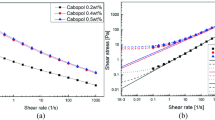Abstract
In this study, numerical and experimental analysis on the spray atomization characteristics of a GDI injector is performed. For numerical approach, four hybrid models that are composed of primary and secondary breakup model are considered. Concerning the primary breakup, a conical sheet disintegration model and LISA model are used. The secondary breakup models are made based on the DDB model and RT model. The global spray behavior is also visualized by the shadowgraph technique and local Sauter mean diameter and axial mean velocity are measured by using phase Doppler particle analyzer. Based on the comparison of numerical and experimental results, it is shown that good agreement is obtained in terms of spray developing process and spray tip penetration at the all hybrid models. However, the hybrid breakup models show different prediction of accuracy in the cases of local SMD and the spatial distribution of breakup.
Similar content being viewed by others
Abbreviations
- a:
-
Ellipse major axis, acceleration
- C:
-
Constant of the CSD model
- CD :
-
Drag coefficient
- C RT :
-
Breakup constant of RT model
- Cτ :
-
RT breakup time constant
- C 0 :
-
Orifice diameter
- d D :
-
Diameter after breakup
- d L :
-
Diameter of the ligament
- K :
-
Density ratio of liquid-gas
- K L :
-
Most unstable wave number of LISA model
- K RT :
-
Wave number of the RT model
- L:
-
Axial distance from the injector
- Lb :
-
Breakup length
- N :
-
Viscosity ratio of liquid-gas
- P:
-
Injection pressure
- r c :
-
Droplet radius after breakup
- t 0 :
-
Thickness of the liquid sheet at the nozzle exit
- t b :
-
Sheet thickness at the breakup length
- t s :
-
Sheet thickness
- U:
-
Total sheet velocity
- y:
-
Magnitude of drop deformation in TAB model
- η0 :
-
Initial amplitude
- ηb :
-
Critical amplitude
- τ:
-
Breakup time
- λ*:
-
Wavelength for the maximum growth rate
- Λ:
-
Growth rate corresponding to maximum growth rate
- ρ:
-
Density
- μ:
-
Viscosity
- Ω:
-
Maximum growth rate
- g:
-
Gas properties
- l:
-
Liquid properties
- LISA:
-
LISA model
- RT:
-
Rayleigh/Taylor wave
References
Bellman, R. and Pennington, R. H., 1954, “Effects of Surface Tension and Viscosity on Taylor Instability,”Quarterly of Applied Mechanics, Vol. 12, pp. 151–162.
Dombrowski, N. and Johns, W. R., 1963, “The Aerodynamic Instability and Disintegration of Viscous Liquid Sheets,”Chem. Eng. Sci, Vol. 18, pp. 203–214.
Fraser, R. P., Eisenklam, P., Dombrowski, N. and Hasson, D., 1962, “Drop Formation from Rapidly Moving Sheets,”AIChE J., Vol. 8, No. 5, pp. 672–680.
Hwang, S.S., Liu, Z. and Reitz, R. D., 1996, “Breakup Mechanisms and Drag Coefficients of High-speed Vaporizing Liquid Drops,”Atomization and Sprays, Vol. 6, pp. 353–376.
Ibrahim, E. A., Yang, H, Q. and Prezkwas, A. J., 1993, “Modeling of Spray Droplets Deformation and Breakup,”AIAA J. Propulsion and Power, Vol. 9, No. 4, pp. 652–654.
Iyer, and Han, Z., 2002, “Fuel Spray Modeling of Outward-Opening Pintle Injectors,” IL ASS Americas, 15th Annual Conference on Liquid Atomization and Spray System, Madison, WI.
Kim, J. I., No, S. Y. and Lim, J. H., 1999, “Modeling Capability of Various Atomization and Droplet Breakup Models for DI Diesel Engines,” The eighth Symposium (ILASS-Japan) on Atomization, Osaka, Japan, pp. 149–154.
Lee,C. S., Lee, K.H., Chon, M. S. and Kim, D. S., 2001, “Spray Structure and Characteristics of High-pressure Gasoline Injectors for Direct-injection Engine Applications,”Atomization and Sprays, Vol. 11, pp. 35–48.
O’Rourke, P. J. and Amsden, A. A., 1987, “The Tab Method for Numerical Calculation of Spray Droplet Breakup,” SAE paper 872089.
Park, S. W., Sung, K. A. and Lee, S., 2001, “Macroscopic Behavior and Spray Characteristics of Gasoline Injector in a Direct-injection Gasoline Engine,” The Eleventh International Pacific Conference on Automotive Engineering (IPC-11), IPC2001D071.
Reitz, R. D., 1987, “Modeling Atomization Processes in High-pressure Vaporizing Sprays,”Atomisation and Spray Technology, Vol. 3, pp. 309–337.
Schmidt, D. P., Nouar, I., Senecal, P. K., Rutland, J., Martin, J. K., Reitz, R. D. and Hoffman, J. A., 1999, “Pressure-swirl Atomization in the Near Field,” SAE paper 1999–01 0496.
York, J. L., Stubbs, H. F. and Tek, M. R., 1953, “The Mechanism of Disintegration of Liquid Sheets,”Trans. ASME, Vol. 75, pp. 1279–1286.
Zhao, F. Q., Lai, M. and Harrington, D. L., 1995 , “The Spray Characteristics of Automotive Port Fuel Injection-A critical review,” SAE paper 950506.
Author information
Authors and Affiliations
Corresponding author
Rights and permissions
About this article
Cite this article
Park, S.W., Kim, H.J. & Lee, C.S. Numerical and experimental analysis of spray atomization characteristics of a GDI injector. KSME International Journal 17, 449–456 (2003). https://doi.org/10.1007/BF02984371
Received:
Revised:
Published:
Issue Date:
DOI: https://doi.org/10.1007/BF02984371




